-
PDF
- Split View
-
Views
-
Cite
Cite
Dan Quach, Sergei Dyda, Richard V. E. Lovelace, Kelvin–Helmholtz instability of counter-rotating discs, Monthly Notices of the Royal Astronomical Society, Volume 446, Issue 1, January 2015, Pages 622–626, https://doi.org/10.1093/mnras/stu2130
Close - Share Icon Share
Abstract
Observations of galaxies and models of accreting systems point to the occurrence of counter-rotating discs where the inner part of the disc (r < r0) is corotating and the outer part is counter-rotating. This work analyses the linear stability of radially separated co- and counter-rotating thin discs. The strong instability found is the supersonic Kelvin–Helmholtz instability. The growth rates are of the order of or larger than the angular rotation rate at the interface. The instability is absent if there is no vertical dependence of the perturbation. That is, the instability is essentially three dimensional. The non-linear evolution of the instability is predicted to lead to a mixing of the two components, strong heating of the mixed gas, and vertical expansion of the gas, and annihilation of the angular momenta of the two components. As a result, the heated gas will free-fall towards the disc's centre over the surface of the inner disc.
1 INTRODUCTION
Commonly considered models of accretion discs have gas rotating in one direction with a turbulent viscosity acting to transport angular momentum outwards and matter inwards. However, observations indicate that there are more complicated, possibly transient, disc structures on a galactic scale. Observations of normal galaxies have revealed co/counter-rotating gas/gas, gas/stars, and stars/stars discs in many galaxies of all morphological types – ellipticals, spirals, and irregulars (Rubin 1994a,b; Galetta 1996; recent review by Corsini 2014). There is limited evidence of counter-rotating gas components in discs around stars (Remijan & Hollis 2006; Tang et al. 2012). Theory and simulations of co/counter-rotating gas/gas discs around stars and black holes predict enormously enhanced accretion rates resulting from the presence of the two components which can give rise to outbursts from these discs (Lovelace & Chou 1996; Kuznetsov et al. 1999; Nixon, King & Price 2012; Dyda et al. 2014).
Counter-rotation in disc galaxies appears in a variety of configurations including cases where (1) two cospatial populations of stars rotate in opposite directions, (2) the stars rotate in one direction and the gas rotates in the opposite direction, and (3) two spatially separated gas discs rotate in opposite directions (Corsini 2014). Of particular interest here is the example of case (3), the ‘Evil Eye’ galaxy NGC 4826 in which the direction of rotation of the gas reverses going from the inner (180 km s−1) to the outer disc (−200 km s−1) with an inward radial accretion speed of more than 100 km s−1 in the transition zone, whereas the stars at all radii rotate in the same direction as the gas in the inner disc, which has a radius of ∼1200 pc (Braun et al. 1994; Rubin 1994b).
On a stellar mass scale, Remijan & Hollis (2006) and Tang et al. (2012) found evidence of accretion of counter-rotating gas in star-forming systems. Accreted counter-rotating matter may encounter an existing corotating disc as in low-mass X-ray binary sources where the accreting, magnetized rotating neutron stars are observed to jump between states where they spin-up and those where they spin-down. Nelson et al. (1997) and Chakrabarty et al. (1997) have proposed that the change from spin-up to spin-down results from a reversal of the angular momentum of the wind-supplied accreting matter. The interface between the oppositely rotating components would be subject to the Kelvin–Helmholtz instability.
In the formation of massive black holes in the nuclei of active galaxies, King & Pringle (2006, 2007) argue that in order for the rapid growth of the massive black holes (observed at high red-shifts) to be compatible with the Eddington limit on their emission, the gas accretion is from a sequence of clouds with randomly oriented angular momenta. This process would lead to the formation of a disc with the rotation direction alternating as a function of radius.
Section 2 develops the theory for the stability analysis and obtains explicit growth rates for the supersonic Kelvin–Helmholtz instability between radially separated co- and counter-rotating thin disc components. Section 3 discusses possible non-linear consequences of the instability. Section 4 gives the main conclusions.
2 THEORY
2.1 Disc equilibrium
We consider the stability of a thin counter-rotating disc around a star or black hole. Fig. 1 shows the rotation curve we consider. We use an inertial cylindrical (r, ϕ, z) coordinate system. The equilibrium has (∂/∂t = 0) and (∂/∂ϕ = 0), with the flow velocity |$\boldsymbol {u} = u_\phi (r) = r\Omega$|. That is, the accretion velocity ur and the vertical velocity uz are assumed negligible compared with uϕ. The equilibrium flow satisfies −ρrΩ2 = −dp/dr + ρgr, where ρ is the density, p the pressure, gr = −∂Φ/∂r, and Φ the gravitational potential. We consider thin discs with half-thickness h ≈ (cs/uϕ)r ≪ r, where cs is the sound speed. In this limit, |$\Omega =(g_r/r)^{1/2}[1+{\cal O}(h^2/r^2)]$|. We consider Keplerian discs where gr = GM/r2 (with M the mass of the central object) as well as more general discs, for example, flat rotation curve discs relevant to galaxies where gr ∝ r−1. We neglect the vertical structure of the equilibrium disc assuming ∂/∂z = 0 for the equilibrium quantities (e.g., ρ, p, and uϕ). Our treatment parallels that of Lovelace, Turner & Romanova (2009; hereafter LTR09), but it generalizes that work to include the z-dependence of the perturbations.
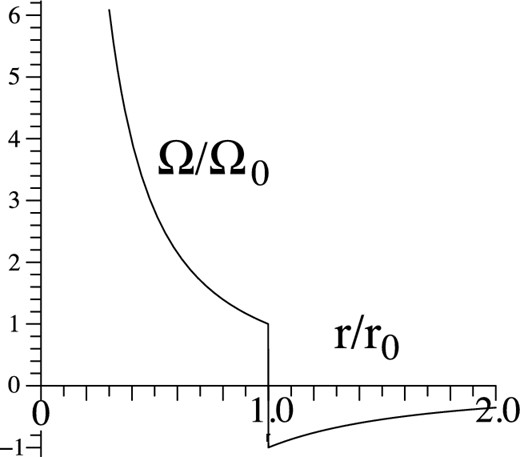
Angular velocity of the counter-rotating Keplerian disc where gr = GM/r2 with M the mass of the central object.
2.2 Perturbation equations
The condition neglecting the self-gravity is that the Toomre parameter Q = κcs/(πGΣ) be larger than about r/h, where h is the disc's half-thickness and Σ = 2hρ is its surface mass density (Lovelace & Hohlfeld 2013).
2.3 Specific model
Important properties of G(ω) are readily verified: first, for m = 0 the perturbation is stable, |${\cal R}=0$|, and therefore kr + = kr − = 0 so that either ω = ±κ (radial epicyclic motion) or ω = ±kz (vertically propagating sound wave). For this reason, we consider m ≥ 1 in the following. Secondly, G(ω) = G( − ω). Thirdly, [G(ω)]★ = G(ω★). It follows that the solutions for ω of G(ω) = 0 = [G(ω)]★ are either purely real or purely imaginary.
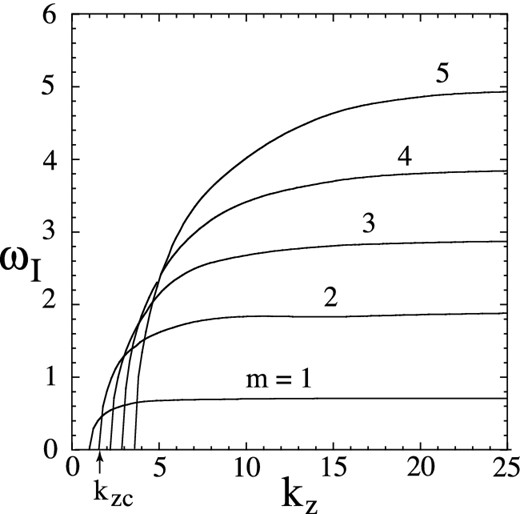
Wavenumber dependence of the growth rate of the instability, ℑ(ω) = ωI, for different values of m for a Keplerian disc with h/r0 = 0.1. Note that ωI is in units of Ω0 and kz is in units of h−1.
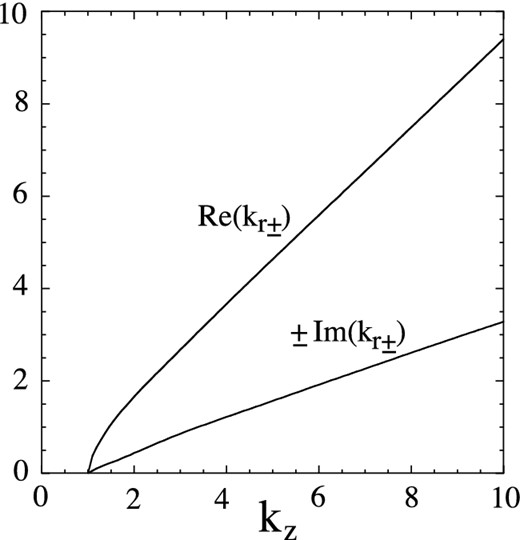
Radial wavenumber, ℜ(kr ±) and ℑ(kr ±), as a function of kz for m = 1 for a Keplerian disc with h/r0 = 0.1. The wavenumbers are in units of h−1.
The growth rates found here are in approximate agreement with the predictions for a planar vortex sheet |$\omega ^2 =(k_\Vert c_{\rm s})^2[1+{\cal M}_p^2/4 -(1+{\cal M}_p^2)^{1/2}]$|, where |${\cal M}_p \equiv (k_\phi /k_\Vert ){\cal M}_T \le {\cal M}_T$| with |$k_\Vert = \sqrt{k_\phi ^2+k_z^2}$| the wavenumber parallel to the interface, and |${\cal M}_T =2 r_0\Omega _0/c_{\rm s}$| the Mach number of the total velocity jump (see, e.g. Choudhury & Lovelace 1984). In this case, instability ω2 < 0 occurs for |${\cal M}_p < 2^{3/2}$| which corresponds to |$k_z h > m(1/2 -h^2/r_0^2)^{1/2} \approx m/\sqrt{2}$|. This agrees with equation (33) for κ = 0. The correspondence of the instability found here and the vortex sheet instability establishes that the instability found here is the supersonic Kelvin–Helmholtz instability. Landau's (1944) study of the stability of a supersonic vortex sheet assumed kz = 0 and found linear stability for |${\cal M}_T > 2^{3/2}$|. However, under this condition linear instability occurs for kz ≠ 0 when |$\left[k_\phi (k_\phi ^2+k_z^2)^{-1/2}\right]{\cal M}_T < 2^{3/2}$|.
3 NON-LINEAR EVOLUTION
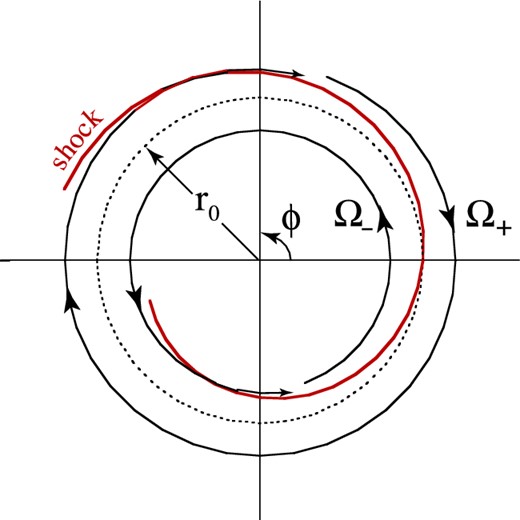
Polar plot of a one armed (m = 1) perturbation which has steepened to form an oblique shock. The gas crossing the shock is deflected towards the interface of the two components.
The spiral wave can lead to the formation of an oblique shock under some conditions. Upstream of the wave, the magnitude of the normal component of the gas velocity relative to the wave is un = θr0Ω0, where θ = m|ℑ(kr ±)r0|−1 ≪ 1. If the upstream normal Mach number |${\cal M}_n = u_n/c_{\rm s} >1,$| there is an oblique shock. On the downstream side, the normal Mach number is less than unity. For r > r0, the gas is deflected inwards and acquires a radial velocity ur = −βr0Ω0, where |$\beta =[2/(1+\gamma )](1-{\cal M}_n^{-2})\theta$|. For r < r0, the oblique shock gives outward radial velocity ur = βr0Ω0.
The co- and counter-rotating disc components have a natural repulsion for each other for the following reason. The mixing of the two components will involve strong shocks. A possible geometry for m = 1 is sketched in Fig. 5 where there are two strong standing shocks, each with Mach number |${\cal M} = u_\phi /c_{\rm s} \gg 1$|. In the region between the shocks, the angular momenta of the two components are annihilated and the gas is strongly heated. The ratio of the gas temperatures downstream to upstream of the normal shock is |$T_2/T_1 \approx 1+2(\gamma -1)\gamma {\cal M}^2/(\gamma +1)^2$|. This ratio is ∼20 for |${\cal M} =10$| and γ = 7/5. The heated gas will expand vertically increasing its scaleheight by a factor |$\sqrt{T_2/T_1}\gg 1$|. With no centrifugal force, the gas will free-fall over the surfaces of the inner disc towards the disc's centre.
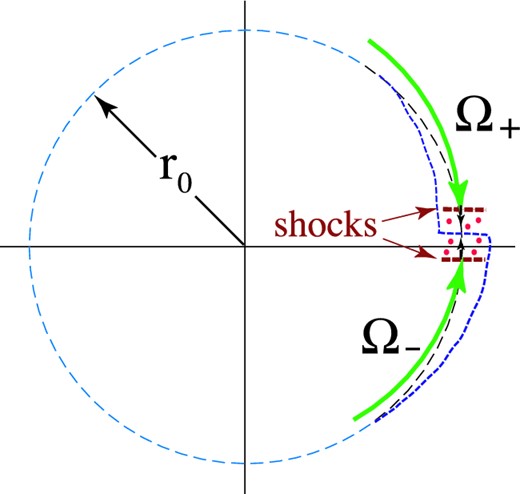
Polar plot suggesting the formation of strong normal shocks leading the annihilation of the angular momenta of the co- and counter-rotating components and the heating of this gas.
The mass-loss rate from this process is |$\dot{M}_{\rm ann} = 4 m h r_0 \Delta r \rho \Omega _0$|, where Δr is the radial amplitude of the interface perturbation. This loss rate is larger than the Shakura & Sunyaev (1973) accretion rate by a factor of the order of |$(m/\pi )(\Delta r/h)({\cal M}/\alpha )$|, where α is the dimensionless viscosity coefficient for a disc rotating in one direction. It is commonly estimated to be in the range 10−3–0.1. The Kelvin–Helmholtz instability evidently gives a spatially localized effective viscosity coefficient |$\alpha _{\rm eff} \sim (m/\pi ) {\cal M}$| assuming Δr ∼ h. Thus, the region between the co- and counter-rotating components will be rapidly emptied of gas and a gap will form. Subsequently, the outer disc will spread inwards and the inner disc outwards due to the turbulent viscosity. Consequently, the gap will close after a definite period and the mentioned heating and annihilation of angular momentum will repeat.
4 CONCLUSIONS
Observations of galaxies and models of accreting systems point to the occurrence of counter-rotating discs where the inner part of the disc (r < r0) is corotating and the outer part is counter-rotating. This work analyses the linear stability of radially separated co- and counter-rotating thin discs. The strong instability is the supersonic Kelvin–Helmholtz instability. The growth rates are of the order of or larger than the angular rotation rate at the interface Ω(r0). The instability is absent if there is no vertical dependence of the perturbation, that is, if kz = 0. That is, the instability is essentially a three-dimensional instability. Thus, this instability is not captured by the analysis of Li & Narayan (2004) where kz = 0 and where the gas is treated as incompressible. Counter-rotating Keplerian discs are unstable for azimuthal mode numbers m = 1, 2, …, whereas for a flat rotation curve relevant to disc galaxies, the unstable mode numbers are m = 2, 3, …. We note that when there is a density change across the interface, there is necessarily a corresponding change in the entropy. This changes the jump condition across the interface and leads in general to propagating unstable modes where ω = ωR + iωI with ωR ≠ 0 and ωI > 0. The important new term in the jump condition comes from the term |$({\cal F}/\Omega L_S^2)\Psi$| on the right-hand side of equation (17).
The non-linear phase of the instability will involve the mixing of co- and counter-rotating gas which will involve strong shocks, strong heating of the gas, and annihilation of the angular momenta of the two gas components. The heated gas will expand vertically and since it has zero angular momentum it will free-fall to the disc's centre over the surface of the inner disc. Thus, the region between the co- and counter-rotating components will be rapidly emptied of gas and a gap will form. In effect, the two components have a repulsive interaction. This is suggestive of the Leidenfrost effect (Leidenfrost 1966) where a liquid droplet is levitated above a hot surface by the vapour pressure between the droplet and the surface. Subsequent to the gap formation, the outer disc will spread inwards and the inner disc outwards due to the turbulent viscosity. Consequently, the gap will close after a definite period and the heating and annihilation of angular momentum will repeat.
Three-dimensional hydrodynamic simulations are of course required to fully understand the non-linear evolution of the counter-rotating discs. Although axisymmetric disc simulations do not allow for the Kelvin–Helmholtz instability, the inclusion of viscosity can model the effect of the turbulent viscosity due to the instability. In an early study by Kuznetsov et al. (1999), the effective viscosity was the numerical viscosity due to the finite grid. In a recent study by Dyda et al. (2014), a high-resolution grid was used with all components of the viscous stress tensor included to model an isotropic Shakura–Sunyaev α-viscosity. Both studies clearly show the development of a gap between the co- and counter-rotating components and enhanced accretion. The study by Dyda et al. (2014) shows the quasi-periodic closing and opening of the gap.
We thank M.M. Romanova for valuable discussions and an anonymous referee for valuable comments. This work was supported in part by NASA grants NNX11AF33G and NSF grant AST-1211318.



